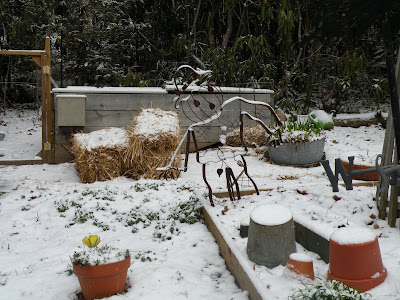We spent the weekend in Chapel Hill with our son and daughter-in-law, Randy and Jenny. Although the temperature was in the low 90's, Saturday was a great day to start a garden. We headed to the Carrboro Farmer's Market early and bought tomato, pepper, squash, cucumber and chive plants. Then onto Southern States for a few more herbs and supplies. My husband had been CH a few weeks ago and he and Randy built a box for compost and started digging this bed. We started with an area of about 8 x 10 feet.
 After a trip to Lowe's, the bed grew to a nice finished size of 8x12.
After a trip to Lowe's, the bed grew to a nice finished size of 8x12. 
Jenny is serious about digging the holes for the tomato plants.

Compost is already off to a good start with leaves and kitchen scraps.

In the small space we planted 4 tomato plants, 6 peppers, 2 squash, 2 cucumbers, 2 basil plants, 4 chives, cilantro, and also a row of green beans along the back edge. Randy and Jenny worked in lots of Black Cow and also added my favorite organic fertilizer, Plant-tone, to each plant. They spread newspaper around each plant and mulched with bark. They also added a center path of pine straw. A good soak with the hose and the garden was finished!
 We also planted a small herb garden, but when I went to get a picture, my memory card was full. I know the kids will keep me updated with pictures of both the herb and vegetable gardens. I also failed to get a picture of Randy at work, but I understand there are some posted on Facebook. I'll check those out later.
We also planted a small herb garden, but when I went to get a picture, my memory card was full. I know the kids will keep me updated with pictures of both the herb and vegetable gardens. I also failed to get a picture of Randy at work, but I understand there are some posted on Facebook. I'll check those out later.We had such a good time doing this, but by 4, we were all ready for a rest and a cold beer. I tried Jenny's favorite Magic Hat #9 and did it ever taste good. Randy and Jenny are coming for a visit in June and I expect to see squash and cucumbers from their garden!

 Honeybees love dandelions and mine are working them heavily. I love the color of the bands on this girl. Make sure to click-on to see all the lovely details.
Honeybees love dandelions and mine are working them heavily. I love the color of the bands on this girl. Make sure to click-on to see all the lovely details.

























